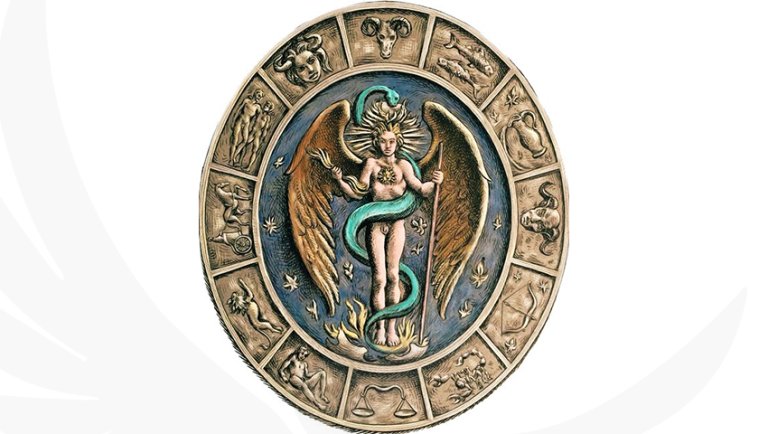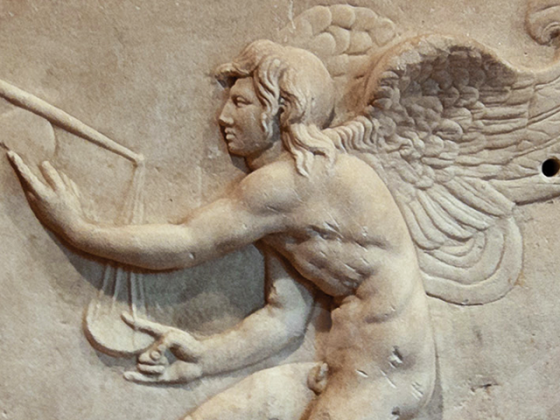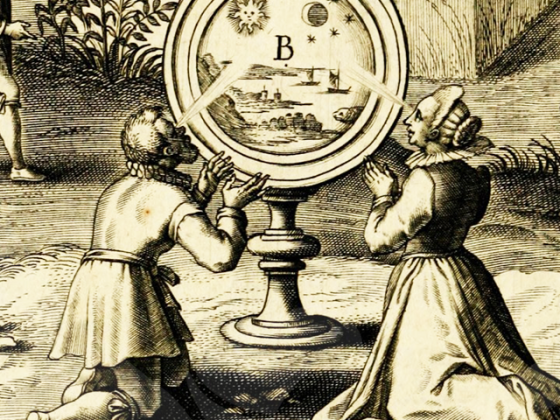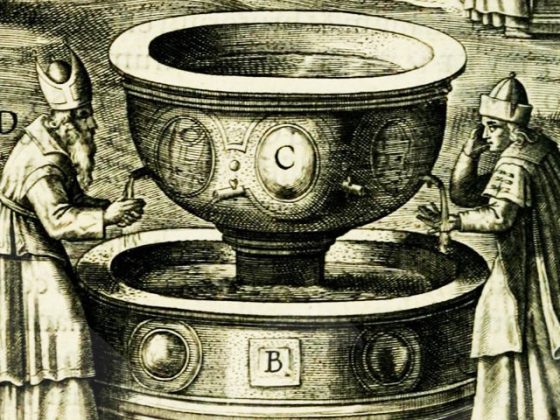Very esteemed readers:
I am pleased to send you some esoteric comments about:
THE GOD PHANES
Before going into the subject, I have to make some comments that I consider important:
Some scholars consider Phanes, Aion, Zervan, the Leontocephalus and Cronus to be the same God.
On the other hand, when we study the doctrine of the V.M. Samael we find that he tells us:
“There we meet directly with the Lords of the Flame, who are true fire. There we find that that power which is latent in the Chaos is an electrical creative power that induces all life in the Universe.
That is what we see in the superior spheres of cosmic creation. The latent fire is a marvel. There we find those igneous breaths of the constellation of Leo, living creatures impossible to describe with words; each one of them living representations of the Sephirotic Crown of the Hebrew Kabbalah, which are Kether, Chokmah and Binah.”
Official science tells us:
“In the Orphic cosmogony Phanes ─in ancient Greek ‘shining'─, Phanetes or Firstborn ─'the first to be born'─ is a god born of the cosmic egg who fabricated or begot Time [in the ether]. He is the primeval deity who constitutes the origin of procreation and the generation of all things. […]
Phanes was the father of the Night ─according to Orphic tradition─, with whom he united to have Heaven and Earth. He was also the father of the Seas, the Sun, the Moon, the stars, Echidna [a monstrous nymph, equivalent to the Lilith of Hebrew legends] and one of the three races of men, also known as the golden race, whom he gave as a place to live in the temperate zone of the Earth. Phanes did all this from inside a grotto, called the Sanctuary of the Night. […]
In the Orphic hymn number VI he is invoked as Protogonus [‘born first', ‘primordial', the Protogenoi are the primordial Gods of Greek mythology]“.
Esteemed readers, I show you here two images: a 16th century drawing by Francesco de Rossi ─Italian painter, 1510-1563─, in which Phanes appears as a hermaphrodite deity, as described by ancient Roman texts, and a Roman high relief.
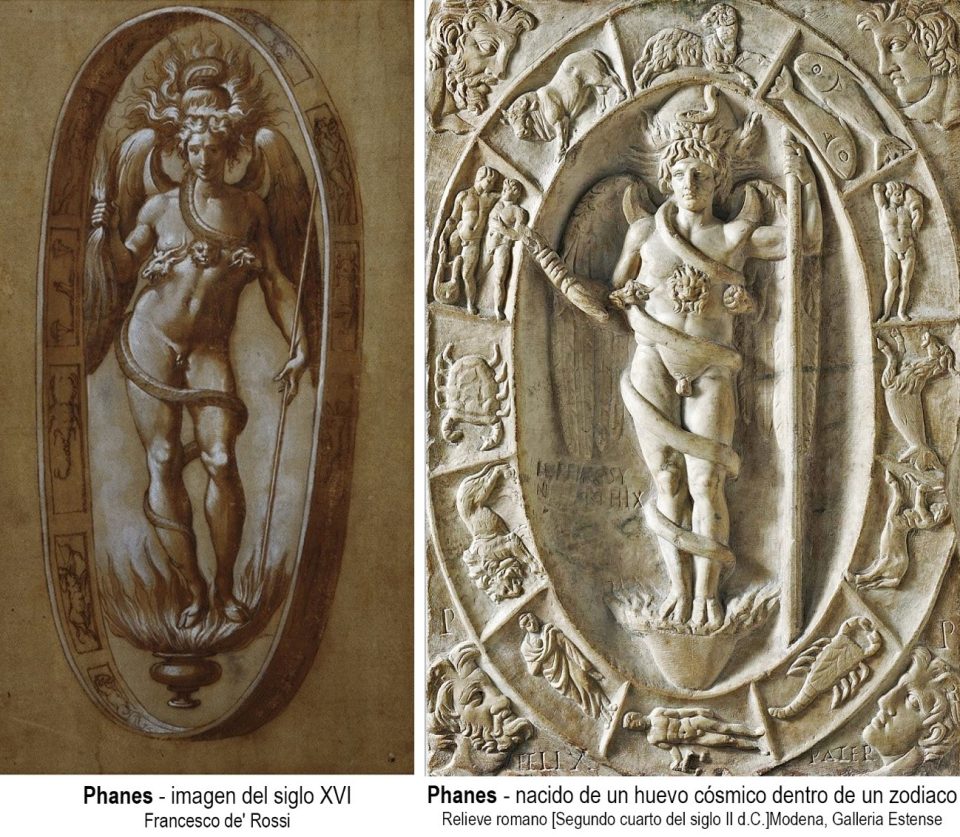
Let us turn now, friends, to the description of these images and their symbols, obviously always in the light of Gnosis.
First of all, let us begin by trying to understand what pertains to God Phanes himself. We are told that such divinity is like the representation of various Gods, among them Cronus ─ who symbolizes time─. It is also explained that it was Phanes who created time, heaven, earth and even a monstrous nymph, and on the other hand we are told that he was the father of the night. These concomitances are indicating that Phanes is the very representation of the Holy Okidanokh, the great fecundator of Mulaprakriti. It is evident that this is why he appears before the earth and the heavens themselves.
It is said, on the other hand, that he was the creator of the seas, the moon, the stars, etc. In other words, he is the great ORGANIZER who emanates, as well commented, from the same cosmic egg or arché of which the V.M. Samael speaks to us.
Something important to keep in mind with this divine representation is the following:
- He is considered immortal, with no beginning or end.
- He is considered the creator of the heaven, the earth, the stars, the moon, the race of the golden men, etc., etc.
- He plans all of creation during the night in a grotto called the Sanctuary of the Night, an allusion to the Cosmic Night or Pralaya.
- All these characteristics are attributable to the HOLY OKIDANOKH.
If we are also told that he is the father of what is known as the race of the golden men, it is being pointed out to us that he is the creator of the divine lineage that populated our world, and therefore the V.M. Samael emphasizes the Lords of the Flame, the creatures made of pure fire similar to the igneous breaths of the constellation of Leo.
It is unquestionable that, since Phanes is the”father of the night,” we are being told that he, most holy, self-conscious and omnipresent, is organizing what will be the next Cosmic Day or Maha-Manvantara on his own during the Cosmic Night or Pralaya. And all this is planned from inside a grotto, this is an allusion to the very bowels of the Absolute Abstract Space. Interestingly, that grotto is called Sanctuary of the Night…….
Let us not forget that the Most Holy Okidanokh crosses all of space and fecundates the entire Mulaprakriti. This includes the very hells of the worlds that are allegorized by the monstrous nymph, similar to the Lilith of the Hebrew Kabbalah.
It is interesting to see that, both under the feet and on the head, appear on this God the two halves of an egg full of flames. This is why it is mythologically said that he himself hatched from the cosmic egg.
Now describing this divinity we will first refer to the image created by Francesco de Rossi.
In it we can observe the God Phanes with hermaphroditic characteristics: female breasts and male phallus. His body shows nudity.
We see him emerging from a kind of vessel full of fire, a vessel that we see present, likewise, in the head of the God, also full of fire.
In his left hand this divinity holds a staff that reminds us of the patriarchal staff, symbol on the other hand of the spine. In his right hand we see a lightning bolt, indicator of the primordial Fohat.
This God has wings on his back and on the top of his back we can see a half-moon. Why? Answer: because Goddesses and Gods are children of the Cosmic Mother.
A kind of serpent-dragon coils around the body of the God Phanes to show us the igneous power that these divinities represent.
The feet of this God appear here as hooves because all these divine manifestations are twinned with the shadow of the Lord Lucifer.
Around this representation we can see the zodiacal belt to remind us that everything has been the child of Fire.
On the chest of this deity a lion's head is exhibited. Let us not forget that, likewise, the lion, in symbolism, alludes to the power of fire. On the sides of this wonderful artistic representation we can see two heads, one of a deer and the other of a ram. That of the ram represents the masculine fire and that of the deer the feminine fire.
Delving now into the other image that alludes to Phanes:
“The figure is standing in a kind of niche, which is set by an elliptical band that is divided into twelve parts. Each part contains a zodiac sign. In the corners the heads of the four winds.”
In this other case, the God Phanes is not shown as a hermaphrodite creature, and instead of female breasts at the chest of this divinity we see the head of a lion. But we do see the God around whom a serpent is coiled up to his head. These representations —the lion's head and the coiled serpent— point to the wisdom of fire.
Here, in this representation of the blessed Phanes, we can also see the two parts of an egg from which incessant flames sprout.
Also, as in the previous image, Phanes‘ feet are like hooves. This is due to the same reason that these divinities are rooted in the Luciferic tradition.
Another very interesting image of Phanes is an engraving made in 1569 by Girolamo Olgiati ─Italian engraver─, Allegory of Alchemy. It is found in the British Museum.
Historians comment that the inscription that appears at the top of the engraving: “Hoc monstrum generat, tum perficit ignis, et Azoch”, means that time produces the primal matter while Fire and Mercury perfect it ─we know that the combined action of Fire and Quicksilver or Mercury transform the primal matter into the Philosopher's Stone─.
Here Phanes has wings in his right hand to signal his divine volatility and omnipresence.
The deity has a trifacial head, under his feet there is a dragon and on the left side a Phoenix bird. The three heads of this divinity point to the three primary forces of creation. The Phoenix bird is a symbol of immortality. The dragon is nothing else than an allusion to Lucifer.
Likewise, in this image Phanes issurrounded by the zodiacal belt, because the primordial fire is the creator of the Cosmoses and everything that is enclosed within them.
In the left hand, in this case, the divinity holds a spear that allegorizes the creative power of the male lingam, or erotic force that carries the fire of fecundation. Likewise, dear reader, we can see on the sides of this figure the head of a ram and the head of a deer, both representations of the masculine and feminine erotic force.
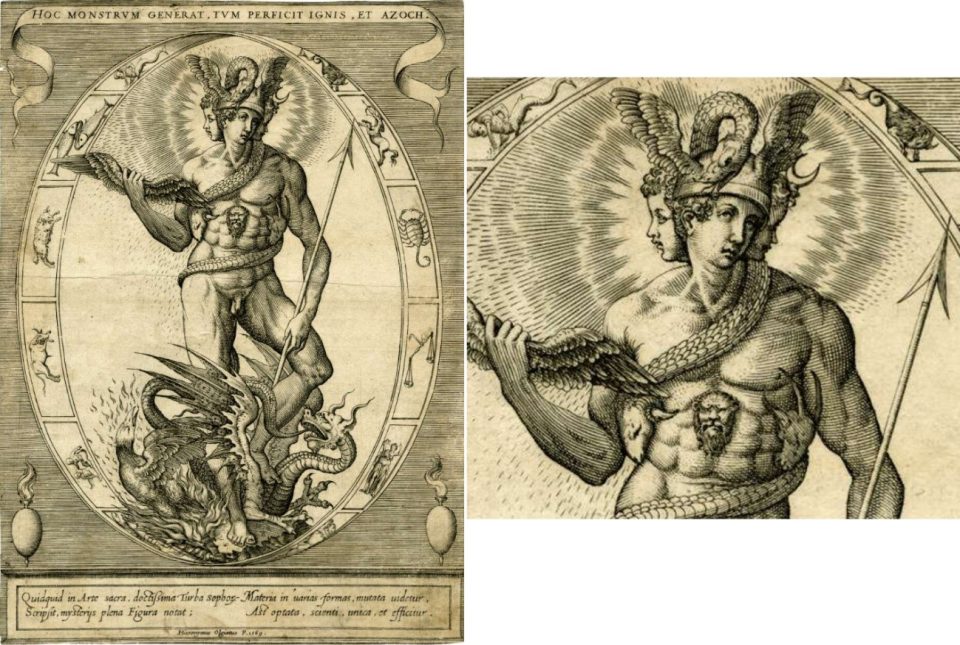
Some scholars relate Phanes to AION, the God of Greek mythology adopted by the Romans and whom they considered supreme and impartial God, the God of eternal Time and Prosperity, having neither beginning nor end. He is, therefore, a God of eternity associated with other mystery religions that have to do with the superior worlds of Consciousness…
Phanes was also related to Zurvan or Zervan, a primeval God of Time and Destiny in Iranian mythology, and to the Leontocephalus of the Mithraic cults, supreme God of eternal Time.
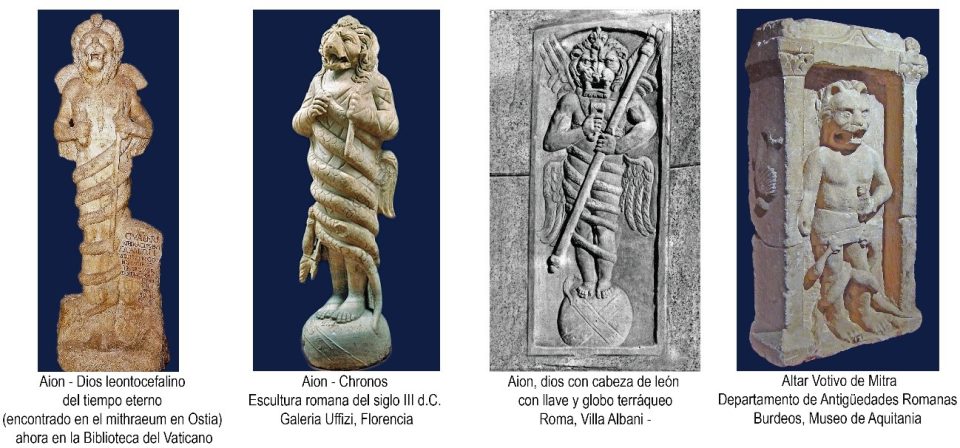
I now send you a few sentences to reflect upon:
“Eternity breaks all measure and destroys all comparison.”
Pierre Nicole
“Hold fast by the present. Each situation, ─nay, each moment─, is of infinite worth; for each represents a whole eternity.”
Goethe
“Eternity, a day without yesterday or tomorrow.”
Massillon
“A look back is worth more than a look forward.”
Archimedes
FAC SIMILE.
─'Act in a similar way'─.
KWEN KHAN KHU


